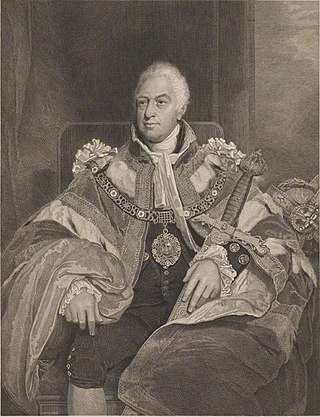Nathaniel Clements, 2nd Earl of Leitrim, KP PC (Ire), styled The Honourable from 1783 to 1795, and then Viscount Clements to 1804, was an Irish nobleman and politician.
Sir Henry Cavendish, 2nd Baronet PC was an Anglo-Irish politician noted for his extensive recording of parliamentary debates in the late 1760s and early 1770s.
County Dublin was a constituency represented in the Irish House of Commons until 1801.

Sir Lancelot Lake (1609–1680) was an English lawyer, landowner and politician who sat in the House of Commons from 1660 to 1679.
The Domville Baronetcy, of St Alban's in the County of Hertford, was a title in the Baronetage of the United Kingdom. It was created on 28 July 1814 for William Domville, Lord Mayor of London from 1813 to 1814. He was a descendant of William Domville, elder brother of Gilbert Domvile, ancestor of the Domvile baronets of Tempoleogue. The title became extinct on the death of the seventh Baronet in 1981.
William Domville (1609–1689) was a leading Irish politician, barrister and Constitutional writer of the Restoration era. Due to the great trust which the English Crown had in him, he served as Attorney General for Ireland throughout the reign of Charles II (1660-1685) and also served briefly in the following reign. It was during his term of office that the Attorney General emerged as the pre-eminent legal adviser to the Crown in Ireland.
The Domvile Baronetcy, of Templeogue and Santry House in the County of Dublin, was created in the Baronetage of the United Kingdom on 22 May 1815 for Compton Domvile, subsequently Member of Parliament for Bossiney, Okehampton and Plympton Erle. He was the son of Charles Pocklington, nephew and heir of the second and last Domvile baronet of the 1686 creation. Charles Pocklington had assumed by royal licence the surname of Domvile in lieu of Pocklington in 1768 on succeeding to the estates of his uncle. The title became extinct on the death of the fourth Baronet in 1935.
Anthony Dopping was the Anglican Bishop of Meath, Ireland.

Sir William Hutcheson Poë, 1st Baronet was an Irish soldier and politician.
John Pocklington (1658–1731) was an English lawyer and Whig politician who sat in the English and British House of Commons between 1695 and 1713. He was appointed a Welsh circuit judge in 1707 and a judge of the Court of Exchequer (Ireland) in 1714, as a result of which he settled in Ireland. He suffered from chronic ill health, and was imprisoned on the orders of the Irish House of Lords in 1719, during a major Constitutional crisis. His descendants, who adopted the surname Domvile, were wealthy landowners in Templeogue, south County Dublin.

Sir William Domville, 1st Baronet was Lord Mayor of London for 1813–14.
The Clerk of the Crown and Hanaper was a civil servant within the Irish Chancery in the Dublin Castle administration. His duties corresponded to the offices of Clerk of the Crown and Clerk of the Hanaper in the English Chancery. Latterly, the office's most important functions were to issue writs of election to the Westminster Parliament, both for the House of Commons and for Irish representative peers in the House of Lords.
Sir Henry King, 3rd Baronet PC (I) was an Anglo-Irish politician.
Sir Compton Domvile, 1st Baronet of Templeogue and Santry House, County Dublin, was an Irish Member of Parliament in the United Kingdom parliament and Governor of County Dublin.
Lady Margaret Frances Domville was an Irish aristocrat and a writer. She was also the daughter of the 3rd Earl of Howth and the wife of Sir Charles Compton Domville, 2nd Bt.

Santry Court was a Georgian house and demesne in Santry, north County Dublin built between 1703-09 on the site of an earlier medieval residence.
Thomas Cobbe (1733–1814), of the Newbridge Demesne in north County Dublin, was an Irish politician.
Sir Compton Domvile, 2nd Baronet was an Anglo-Irish politician.
Sir Thomas Domvile, 1st Baronet was an Anglo-Irish politician.
Charles Domvile was an Anglo-Irish politician.





